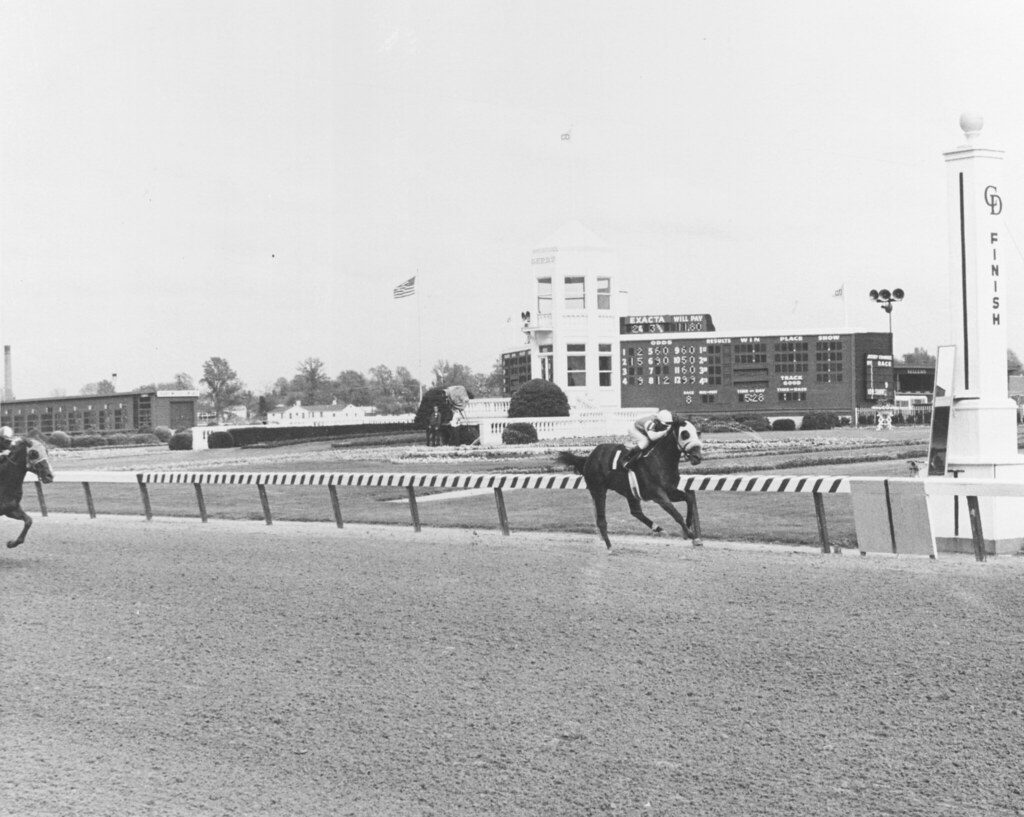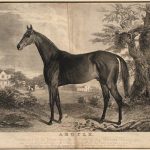BackTracks: Key to the Mint unlocks a title
The gray and yellow silks of Rokeby Stables were a familiar sight during the middle decades of the 20th century. Paul Mellon’s investment in breeding in the Mid-Atlantic yielded a series of good horses that performed at the highest level on the sport’s biggest days. On his long list of champions is a name that confronted horses like Riva Ridge and Autobiography more than once and came out on top.
Key to the Mint’s time on the racetrack might have been overshadowed by other horses, including some of Rokeby’s, but his performances put him among the best horses of the 1970s, a time when greats like Secretariat and Forego dominated the racetrack.
An Old Dominion Exemplar
The story of Mellon’s start in horse racing is a familiar one: the only son of Andrew Mellon, businessman and Secretary of the Treasury for three presidents, and Nora McMullen, he was educated in both the United States and England before settling in Virginia. He purchased Rokeby, a 400-acre farm near Upperville from his mother, and pursued his passion for horses there, building a breeding operation that produced winners over the jumps and on the flat.
For five decades, Rokeby bred Triple Crown classic winners and an Epsom Derby victor, all foaled at Mellon’s ever-expanding farm. One of his best mares was a daughter of Princequillo named Key Bridge. She had already produced a Horse of the Year in the turf specialist Fort Marcy, and in March 1969, she foaled a plain bay colt by Graustark, whom Mellon would name Key to the Mint.
When Key to the Mint was ready for the racetrack, he was turned over to Elliott Burch, the third-generation horseman who conditioned Mellon’s American horses for a decade. With a shadow roll and blinkers to keep his mind on his job, Key to the Mint’s debut came in summer 1971, those early races setting the stage for the battles to come.
A Tale of Three Races
On June 23, 1971, the plain bay colt joined seven others for a maiden special weight race at Belmont Park. As the favorite, the royally bred Key to the Mint went off at 4-5 while another promising colt by the name of Riva Ridge, owned by Meadow Stable, was bet down to 2-1. The Rokeby colt broke from post five while Riva Ridge was to his inside in post two. At the break, the Meadow Stable colt got the jump on Key to the Mint, holding on to a half-length lead through the first quarter of the 5 ½ furlong test.
Key to the Mint stuck his head in front as they entered the stretch, but Riva Ridge was too much horse that day. He drew off to a 5½-length win over the Rokeby hopeful, who was 3½ lengths ahead of Candyville. The Graustark colt would break his maiden in his next start at Aqueduct and then face another loaded field in an allowance race ten days later.
CHECK OUT THE LATEST OFF TO THE RACES RADIO!
This one was another 5½-furlong test versus a field of ten others, including Spanish Riddle and the Maryland-bred Bee Bee Bee, both future graded stakes winners. Key to the Mint broke again from post five with Spanish Riddle to his outside in post eight and Bee Bee Bee to his inside in post three. The Rokeby colt broke clean and sat back in third early. In the stretch, Key to the Mint moved to the lead, a half-length clear of Lucky Bidder, Bee Bee Bee in third, but the latter closed fast to win by a length over Lucky Bidder with the son of Graustark back in third.
Key to the Mint struggled a bit at shorter distances, with stakes tries in the Futurity and the Cowdin at Belmont and the Garden State Futurity at Garden State Park netting him only a runner-up finish in the Cowdin. But his pedigree promised stamina via both Graustark and Princequillo, and when the Rokeby colt stretched out to seven furlongs and then a mile, he was more consistent and made his next stakes try a winning one.
On November 26, Key to the Mint faced nine others in the one-mile Remsen at Aqueduct. With Braulio Baeza in the saddle, Burch changed up his orders for Key to the Mint. Instead of sitting just behind the leaders early, Baeza kept his mount midpack until the far turn, going four-wide into the stretch. Determined Cosmic made his bid in the last furlongs as well, taking the lead as Key to the Mint was closing fast on his outside. Passing Determined Cosmic in the final yards, the Rokeby colt earned his first stakes win by a half-length.
With a record of five wins in ten starts, Key to the Mint was poised for a promising three-year-old season. Rated at 121 pounds on the Experimental Free Handicap, the son of Graustark was ranked five pounds below champion Riva Ridge ahead of the 1972 season.
“Really by the end of the season, he was just learning what it’s all about,” trainer Elliott Burch said prior to the colt’s first 1972 start. “I think I’ve got the best shot with him I’ve had with anyone.”
A Winning Streak

Injuries, though, would stand in the way of Key to the Mint’s progress early that season. He bruised a stifle coming out of the gate in his second start, a six-furlong allowance at Hialeah, and rested until early May. The colt had recovered enough to try the Derby Trial four days before the 1972 Kentucky Derby and came away with a win. Despite that, Burch elected to bypass another go at Riva Ridge in the Run for the Roses, instead pointing Key to the Mint for the Preakness Stakes.
On a sloppy track, Bee Bee Bee surprised everyone with his 1¼-length victory, with Key to the Mint and Riva Ridge coming in third and fourth, respectively. The Rokeby colt next took the Withers Stakes between starts in the Preakness and the Belmont but ran out of gas in the latter to finish fourth behind Riva Ridge. With the Triple Crown season done, Burch gave the son of Graustark a break before the summer stakes.
In his next start, the 1 3/16-mile Brooklyn Handicap where he faced older horses, Key to the Mint took the lead early and maintained his advantage in a race where no others wanted to run on the front. Able to control the pace early, jockey Baeza had plenty of horse left at the end, winning by two lengths. For his next start, the Rokeby colt continued racing against older horses in the nine-furlong Whitney Stakes at Saratoga. Facing a field of seven others, Key to the Mint broke alertly, battled Triple Bend and Indian Good around the first turn, and then went to the front on the backstretch, taking advantage of the slow pace to maintain his lead all the way to the wire.
His two wins against older horses showed that the Graustark colt was coming into his own in the second half of his three-year-old season; his next start in the Travers would give Eclipse voters another reason to rank Key to the Mint higher than even Riva Ridge. Against a field of six fellow sophomores, the Rokeby colt and race favorite sat third behind North Sea, who set a quick pace of :22 3/5 for the first quarter, :45 3/5 for the half-mile, and 1:09 2/5 for six furlongs.
“I took a light hold of my horse and put him in position. I could see the other horse (North Sea) going fast, setting a good pace,” jockey Braulio Baeza said after the Travers. “He [Key to the Mint] rated kindly, which is important. I didn’t want to go head-to-head with that leader.”
On the far turn, the field caught up to the tiring North Sea, and as Tentam moved, so did Key to the Mint. Baeza had his mount in a drive, but Tentam wasn’t relenting either. The Rokeby colt slowly whittled down his rival’s advantage until the eighth pole, when Baeza tapped his mount five times, pushing the colt to give that last bit of effort and win by a length.
Six weeks later, Key to the Mint again faced older horses – and Riva Ridge – in the Woodward Stakes and again came out on top. This time, Riva Ridge engaged the Rokeby colt early, the two leading the field of ten around the first turn and took a short lead on the backstretch. Baeza kept his mount close and pressed the Derby-Belmont winner around the far turn and then to the head of the stretch. With three furlongs to go, the jockey saw that Riva Ridge was finished and sent Key to the Mint on, shaking the colt up ahead of the wire as stablemate Summer Guest made her bid on the outside.
It was his fourth consecutive win and his third outside of his division. Despite a loss to Autobiography in the Jockey Club Gold Cup, Key to the Mint’s seven wins in twelve starts in 1972 was enough to earn him the Eclipse for Champion Three-Year-Old Colt.
A Forgotten Champion
At four, Key to the Mint notched three wins in seven starts, adding the Excelsior and Suburban Handicaps to his resume of stakes wins. Poor performances in the Marlboro Cup and the United Nations Handicap, his lone start on the turf, prompted owner Paul Mellon and trainer Elliott Burch to retire the colt.
“Something is the matter with him so I’m going to retire him,” Burch said when he announced the Rokeby colt’s exit. “The horse is not running to form, and every time he’s beaten, he hurts his reputation.”
His career done, Key to the Mint retired to Greentree Farm near Lexington, Kentucky. When Greentree later became part of Gainesway Farm, Mellon’s champion remained there until his death in 1996. During his twenty-two seasons at stud, Key to the Mint produced horses like Plugged Nickle, 1980’s champion sprinter; Java Gold, winner of the 1987 Travers; and 1979 Canadian Champion Three-Year-Old Filly Kamar.
Paul Mellon’s Rokeby Stable had its share of champion horses over his decades in the sport, winning a Kentucky Derby with Sea Hero, an Epsom Derby with Mill Reef, and Belmont Stakes winners in Quadrangle and Arts and Letters. His colors were seen in the Travers’ winner’s circle five times, including in 1972 when Key to the Mint battled Tentam down the stretch. In a time dominated by Meadow Stable’s Riva Ridge and Secretariat, Mellon’s horse made his own mark on the sport and gave the Mid-Atlantic another name on its long list of champions.
SOURCES
- http://www.americanclassicpedigrees.com/key-to-the-mint.html
- http://www.americanclassicpedigrees.com/graustark.html
- http://www.americanclassicpedigrees.com/key-bridge.html
- http://www.americanclassicpedigrees.com/princequillo-ire.html
- http://www.americanclassicpedigrees.com/java-gold.html
- http://www.americanclassicpedigrees.com/kamar-can.html
- http://www.americanclassicpedigrees.com/bee-bee-bee.html
- https://en.wikipedia.org/wiki/Key_to_the_Mint
- https://en.wikipedia.org/wiki/Graustark_(horse)
- https://en.wikipedia.org/wiki/Plugged_Nickle
- https://en.wikipedia.org/wiki/Paul_Mellon
- https://en.wikipedia.org/wiki/Andrew_Mellon
- https://en.wikipedia.org/wiki/Rokeby_Stables
- https://en.wikipedia.org/wiki/J._Elliott_Burch
- https://www.theracingbiz.com/2022/11/15/backtracks-fort-marcys-trip-from-reject-to-record-setter/
- https://www.theracingbiz.com/2023/08/08/backtracks-the-mighty-mill-reef/
- https://www.theracingbiz.com/2021/10/14/backtracks-run-the-gantlet/
- https://www.theracingbiz.com/2020/10/19/backtracks-elliott-burch/
- https://www.secretariat.com/askin-haskin/06/22/2021/riva-ridge-maiden-win-was-key-to-lasting-rivalry/
- https://vault.si.com/vault/1972/10/09/man-with-a-key-to-a-championship
- https://www.thoroughbredracing.com/articles/5410/memories-paul-mellon-fascinating-insights-racing-museums-team-honour-iconic-figure/
- https://www.racingmuseum.org/hall-of-fame/pillar/paul-r-mellon#:~:text=In%201948%2C%20Mellon%20began%20racing,both%20an%20owner%20and%20breeder
- https://www.racingmuseum.org/hall-of-fame/trainer/j-elliott-burch
- https://paulickreport.com/news/people/hall-of-fame-trainer-elliott-burch-dies/
- https://www.bloodhorse.com/horse-racing/articles/138266/hall-of-fame-trainer-elliott-burch-dies
- https://www.americasbestracing.net/the-sport/2019-paul-mellon-pillar-the-turf
PRINT SOURCES
Adair, Bob, “Key to the Mint Romps by 2 ½ in Derby Trial,” Louisville Courier-Journal, May 3, 1972.
Boniface, William, “Tentam Gets Bid to International,” Evening Sun, September 28, 1973.
“Derby Favorite? It’s Riva Ridge,” Orlando Evening Star, February 22, 1972.
Gaffer, Wes, “Derby Advice from a Bevy of Turf Gals,” Daily News, May 3, 1972.
Harris, Russ, “5 Top Sprinters Head Field of 11 in Opening-Day Feature at Atlantic City,” Philadelphia Inquirer, August 29, 1973.
“Key to the Mint Is Easy Winner,” Commercial Appeal, July 9, 1972.
“Key to the Mint Wins,” Newsday, August 6, 1972.
McCulley, Jim, “Key to the Mint Wins Remsen,” Daily News, November 27, 1971.
McCulley, Jim, “Key to the Mint Wins Whitney,” Daily News, August 6, 1972.
Nack, Bill, “Key to the Mint Wins Woodward,” Newsday, October 1, 1972.
Nack, Bill, “Trainer Unlocked Key to the Mint,” Newsday, April 15, 1973.
Nack, Bill, “Key to the Mint Wins Travers Duel,” Newsday, August 20, 1972.
Nack, Bill, “Key to the Mint Finds a Dry Track,” Newsday, July 9, 1972.
Phelps, Frank T., “No Major Kentucky Foaled, Sired Stakes Winners in Weekend Racing,” Lexington Herald, October 2, 1972.
“Riva Ridge Early Derby Choice,” Oakland Tribune, February 22, 1972.
“Riva’s ‘Never Lost a Lead,’ Turcotte Notes,” Miami Herald, June 11, 1972.
Schuyler, Ed, Jr., “Riva Ridge, Key to the Mint Hopefuls,” Ithaca Journal, February 22, 1972.
Ward, Gene, “Key to the Mint Opens Derby Lock in Trial by 2½,” Daily News, May 3, 1972.
LATEST NEWS












